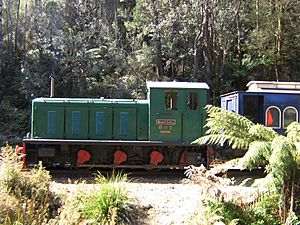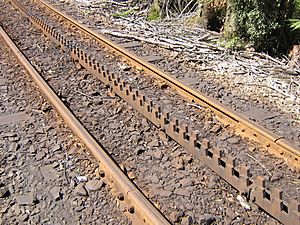West Coast Wilderness Railway facts for kids
Quick facts for kids West Coast Wilderness Railway |
|
|---|---|
 |
|
| Locale | West Coast, Tasmania |
| Terminus | Queenstown and Strahan |
| Commercial operations | |
| Built by | Mount Lyell Mining and Railway Company |
| Original gauge | 3 ft 6 in (1,067 mm) |
| Original rack system | Abt rack system |
| Preserved operations | |
| Owned by | Government of Tasmania |
| Operated by | Abt Railway Ministerial Corporation |
| Stations | Regatta Point, Teepookana, Dubbil Barril, Rinadeena, Lynchford, Queenstown |
| Length | 34.5 km |
| Preserved gauge | 3 ft 6 in (1,067 mm) |
| Preserved rack system | Abt rack system |
| Commercial history | |
| Opened | 1 November 1899 |
| Closed | 10 August 1963 |
| Preservation history | |
| 2002 | Reopened under the name of the Abt Wilderness Railway |
| 2013 | Federal Hotels stopped operations |
| 2014 | Reopened as the West Coast Wilderness Railway |
| Website | |
| http://www.wcwr.com.au | |
The West Coast Wilderness Railway is a special train line in Tasmania, Australia. It was rebuilt from an old railway that connected Queenstown and Regatta Point, Strahan. This railway is famous for its unique Abt rack system. This system helps the train climb steep mountains through thick rainforests.
Some of the original trains still run on the tracks today! Now, the railway is a fun tourist attraction. It teaches visitors about the history of Tasmania's West Coast. The first railway started way back in 1897. It was the only way to travel between Queenstown and the port of Strahan.
Contents
Railway History
Building the Original Line
The Mount Lyell Mining Co started its work in November 1892. This company later became the Mount Lyell Mining and Railway Company. The railway officially opened in 1897. Then, on November 1, 1899, the line was made longer. It stretched all the way from Teepookana to Regatta Point and Strahan.
This railway was super important for moving copper. Copper from the mine at Queenstown needed to get to markets. Until 1932, it was the only way to reach Queenstown. A road to Hobart was built later that year.
How the Abt System Works
The railway used a special design called the Abt rack and pinion system. This system helped the trains climb very steep hills. Because of these steep parts, trains could only carry a limited amount of weight. The tracks are 3 ft 6 in (1,067 mm) wide.
The original line went right into the Mount Lyell mining area in Queenstown. At Regatta Point, the line connected to another railway. This other line went around the coast of Strahan to Zeehan.
Why the Railway Closed
The railway stopped running on August 10, 1963. It cost too much money to keep it working. Also, new roads made it easier to get to the West Coast. The last train was pulled by locomotive no. 1. This was the same engine that ran the very first service in 1896.
After it closed, the train tracks were removed. Other movable parts were taken away. But most of the bridges were left standing. The trains were sent to different places. Locomotive no. 5 and some carriages went to the Puffing Billy Railway in Victoria. Other engines were put in museums.
The path where the tracks used to be was sometimes used by cars. This was especially true from Regatta Point to Lette's Bay. Most of the old bridges stayed but slowly fell apart. The path was not good for cars past the Iron Bridge. This bridge crosses the King River at Teepookana.
Steepest Part of the Track
The steepest part of the railway was very impressive. It was a 1 in 12 slope, which is super steep! This section is between Dubbil Barril and Rinadeena. It's the steepest hill a regular train has ever climbed in the Southern Hemisphere.
Rebuilding the Railway
After 1963, many people wanted to bring the railway back. But it wasn't until the 1990s that it happened. Local people on the West Coast worked hard to restore the Abt Railway. They wanted it to be a heritage tourist attraction. They wanted to show off its unique rail system and the area's mining history.
The Australian Government helped a lot. They gave $20 million from a special fund. The State Government also gave money. Some private investors helped too.
The New Railway Opens
The rebuilt railway started running on December 27, 2002. It was called the Abt Wilderness Railway. The Prime Minister, John Howard, and the State Premier, Jim Bacon, officially reopened it in 2003.
The new station in Queenstown is in the same spot as the old one. The station at Regatta Point was also fixed up. The railway follows its original path almost perfectly. The only change is the Quarter Mile Bridge near Teepookana. The old bridge was washed away in a flood in 1974. The new bridge is a bit shorter and built just south of the original spot.
Changes in How It's Run
On February 4, 2013, the Federal Group announced something big. They said they would stop running the railway in April 2013. They explained that business was slow. Also, the railway needed a lot of money for repairs. The Tasmanian government said it would cost $15 to $20 million to keep it going. They couldn't pay for it alone.
After some track repairs, the railway reopened on January 6, 2014. It ran between Queenstown and Dubbil Barril. On December 14, 2014, it started running its full length again. Now, a government company called the Abt Railway Ministerial Corporation runs it.
Train Stops and Features
Most of the old train stops and famous places along the line are still there. This list goes from Queenstown to Regatta Point. You can read it backward for the trip from Regatta Point.
- Queenstown (the start or end point)
- crosses the Queen River
- Lynchford
- Halls Creek
- Rinadeena
- enters the western end of the King River gorge
- Dubbil Barril (sounds like "double barrel")
- "Quarter Mile Bridge" (the original was destroyed by floods, the new one is shorter)
- crosses the King River for the first time
- Teepookana
- "Iron Bridge"
- crosses the King River for the second time
- the train line is closest to the King River between these two bridges
- leaves the King River near where it flows into Macquarie Harbour and heads north towards Regatta Point and Strahan
- Lowana
- Regatta Point (the start or end point)
The Federal Hotels group used to own and run the railway. They also own other tourist places in Strahan.
Train Engines and Carriages
The West Coast Wilderness Railway has three of the five original engines. These are from the old Mount Lyell Mining and Railway Company. Locomotives 1, 3, and 5 are still working! Engine number 2 is expected to be ready again in 2021 after repairs.
The railway also has two diesel locomotives. The passenger carriages are quite new. They were built when the line reopened in 2002. They are comfortable for passengers all year round.
Engineering Award
The railway is so special that it won an award. It received an Engineering Heritage International Marker. This award is from Engineers Australia. It's part of their program to recognize important engineering projects.
Current Train Trips
Before the COVID pandemic, the railway offered four different trips. You could start from either Strahan or Queenstown. Some trips went the whole way, others just part of the line. All tours include stops along the way. You can get off the train to explore the forest or enjoy the views. There are two types of tickets: standard and heritage.
Services were stopped during COVID lockdowns. Now, the trains are starting to run again!
Further Information
If you want to learn more, Lou Rae has written several books. He writes about the railways on the West Coast.





